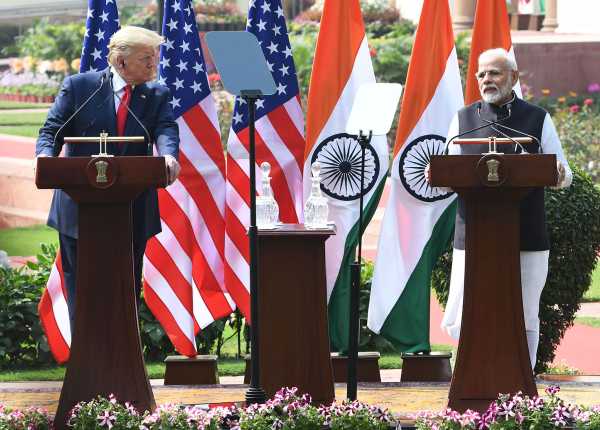
An effective communicator with a questionable past builds a successful campaign as an outsider disinterested in everyday, run-of-the-mill politics. He smartly taps into the fears and anxieties of voters and projects himself as the only person who can fix the supposedly broken system.
Despite warnings from ex-associates and journalists regarding his sociopathic behavior, he decries the media and political opponents as unpatriotic. Policy wonks and veterans in his party are sidelined to create a personality cult unmoored from any ideology. Social media is used daily for dog-whistle rhetoric to promote the cultural supremacy of his ilk.
Donald Trump Proves That It’s the System, Stupid
READ MORE
By blaming all the socio-economic ills on outsiders, previous administrations and “others,” he builds a narrative of victimhood. His devoted followers start living in an alternate universe. Once in power, he uses his bully’s pulpit to undermine all democratic institutions.
Riding Out the Storm
You would be forgiven for thinking that this was about Donald Trump. But this is the story of India’s prime minister, Narendra Modi. The similarities end there, however. While the United States managed to pull back from the brink after the Capitol Hill insurrection of January 6, Indian democracy is in a dangerous downward spiral.
To understand these divergent trajectories of the oldest and the largest democracies in the world, it is instructive to examine the key differences between Trump’s and Modi’s personalities, the maturity of democratic institutions in the United States and India, and the histories of these two republics.
In the US, Trump’s effort to subvert democratic institutions has been well documented, with commentators still writing about how close the country had come to a constitutional crisis in his final days in office. Trump tried his best to manipulate all the American institutions, but there was rarely any method to his madness. Unlike Modi, he was more interested in vanity than power.
On a given day, he could draw lines on a map for petty reasons and undermine the National Oceanic and Atmospheric Association or brazenly call the officials in Georgia and ask them to “find” enough votes in Trump’s favor to reverse the election result in the state. As much as Trump and his partner-in-crime, Attorney General William Barr, tried, they could not corrode the integrity of the system beyond a certain point.
Make Sense of the World
Unique Insights from 2,500+ Contributors in 90+ Countries
I agree to receive emails and other content from Fair Observer. I understand that I may repeal my consent at any time. You can review our Privacy Policy and Terms of Use for further information…
Despite Trump’s vilification, the media stayed strong and kept hammering home the truth. While Trump tried to use the judiciary to run down the clock on several grave constitutional issues, scores of judges, including several appointed by the president, stood up to him when it mattered the most. The legislature impeached but failed to convict him twice. However, when push came to shove, it certified the votes and declared Joe Biden as the legitimate winner of the 2020 election.
Barring a few minor missteps, the FBI withstood a concerted pressure campaign from Trump and his allies. The Federal Reserve, the Federal Election Commission, the intelligence agencies, vast bureaucracies and diplomats around the world kept their heads down and rode out the storm. With more than two centuries of experience, most American institutions have learned the importance of guarding their turf.
Taming the Bureaucracy
In India, on the other hand, while running his home state of Gujarat before becoming prime minister, Modi had perfected the art of taming the bureaucracy to his will, manipulating or marginalizing the media and polarizing the electorate for his narrow purposes. While he did deliver on a few key infrastructure promises, he also carefully crafted a larger-than-life persona around himself. As soon as he became prime minister, he stopped interacting with the media.
Well before facing reelection in 2019, he enacted an anonymous political funding system and used it to build a formidable social media propaganda machine to fabricate an alternate universe for his voters. Behind the scenes, he methodically started dismantling the democratic checks and balances. While Trump’s Senate Majority Leader Mitch McConnell might not have been intent on destroying American institutions, Modi proved to be more like McConnell than Trump — someone playing the long power game.
While previous governments of opposing parties were often guilty of undermining democracy, the brazenness and the cold, calculating manner in which Modi has approached it are astonishing. By using obscure parliamentary maneuvers, the prime minister has repeatedly sidelined or manipulated the Rajya Sabha, the upper house of Parliament, to pass laws that have long-term and far-reaching social consequences.
Embed from Getty Images
In addition to passing questionable constitutional amendments to enact his anonymous political funding scheme, the Right to Information Act (the equivalent of the American Freedom of Information Act) was amended so that those ensuring public access to non-classified government records lost their independence. As a consequence, it became increasingly difficult to shed light on the government’s opaque decision-making.
The enormous war chest built through anonymous political donations, the government’s sizable advertising budget and the threat of central investigative agencies were used to browbeat most of the media outlets into submission. A top Election Commission official who took a stand against Modi’s incendiary rhetoric in the run-up to his reelection was reassigned to the Asian Development Bank, headquartered in the Philippines.
The Reserve Bank of India, in charge of the country’s monetary policy, has been repeatedly coerced into taking unsound policy decisions and covering up for the government’s fiscal and economic policy failures. Policymaking powers of at least two states, Jammu and Kashmir and Delhi, have been curtailed through potentially unconstitutional means, disturbing India’s federal structure. The military has been repeatedly co-opted for Modi’s photo-ops to promote phony nationalism. Meanwhile, the Supreme Court has been a mute spectator, keeping on hold the hearing of cases related to some of the most pressing constitutional issues.
As the unfolding global Pegasus spyware scandal indicates, Modi has probably compromised the judiciary’s independence as well. By allegedly hacking the phones of everyone from political rivals, constitutional authorities, judges, their staffers to activists, journalists and even his own ministers and friends in the private sector, Modi seems to have established an Orwellian surveillance-coercion state in which it is extremely difficult, if not impossible, to challenge the power of his executive branch.
Opposite Paths
Why have India and the US embarked on such opposite paths? One reason is the difference between the two leading men themselves. A devoted foot soldier of right-wing Hindu majoritarian ideology, Modi rose through the political ranks and served more than two terms at the helm of the state of Gujarat before running for the highest office in the land. He had carefully studied all levers of executive and bureaucratic power and, along with his deputy, Amit Shah, had already gained notoriety as one of the country’s most ruthless politicians.
While both ran their campaigns as outsiders, Trump’s understanding of the government machinery was limited. As former National Security Adviser John Bolton recently pointed out, Trump is incapable of staging a coup because he lacks the attention span required for it. With no discernible political acumen, Trump was incapable of looking beyond the next news cycle or his narrow self-interest.
Embed from Getty Images
The American system dodging the Trump bullet and the Indian system crumbling under Modi also reflect the wide gulf in their socio-cultural values. By insisting on universal adult suffrage from its inception, the founding fathers of the Republic of India expressed tremendous faith in the citizenry and future leaders despite a severe resource crunch, a moribund economy and near-total absence of infrastructure for health, education or even basic transportation.
While giving every adult the right to vote is hailed as a quintessentially Indian revolution, and rightly so, it has been a double-edged sword. On one hand, it has dismantled the centuries-old feudal social structures and slowly empowered historically oppressed castes. On the other, limited institutional capacity and lack of appreciation for their independence among voters have made the Indian system susceptible to demagoguery in the short run. This will change as India becomes more prosperous and internalizes the benefits of decentralizing power, but that brings into sharp relief Modi’s betrayal of his mandate.
Fledgling Democracy
At 75, India is still a fledgling democracy. It has already gone through one emergency under former Prime Minister Indira Gandhi, when all institutions, state and national elections, and fundamental rights were suspended amid near-total media censorship. While the Supreme Court took corrective action after the emergency, widespread poverty and, until recently, low levels of literacy have hampered rapid institutional capacity building in India. Corruption is endemic to all branches of government, making them easy targets for manipulation.
In its short history as a republic, the socialist economic model adopted by India’s pre-1990 governments has also created a new feudal system in the form of political patronage. With the government tightly controlling the economy, politicians became the new overlords picking winners and losers. As the initial euphoria and idealism following independence faded, criminals came to dominate politics. Corruption became the mainstay of political life.
While these might be birth pangs of any new republic — and might find parallels in the early decades of the existence of the United States — complacency and arrogance of the Indian National Congress (INC), India’s GOP, has fueled the rise of Modi.
A Modi-fied India Has Weakened on the World Stage
READ MORE
In the 1970s and 1980s, a 21-month-long national emergency, followed by legislative action favoring minorities to protect the INC’s own vote banks, had led to resentment among the Hindu majority. Instead of correcting some of these historic wrongs to move the discourse to a liberal center, Modi has swung it to the extreme right. He has not taken any overt steps that resemble the emergency that Indira Gandhi declared in 1975. Instead, he has chosen covert means to slowly and deliberately dismantle the Indian system of governance.
More importantly, while Gandhi’s methods were largely populist, Modi has added toxic majoritarianism to it, making this movement more dangerous, with potentially longer-lasting consequences. For someone who claims that he developed his political consciousness during the emergency, Modi’s assault on the liberal system that enabled his rise from humble beginnings is truly ironic.
A leader who promised to decentralize power and dismantle India’s new feudal system of political patronage now presides over one of the most centralized decision-making structures. When the framers of the Indian Constitution chose universal adult suffrage, they also expected elected leaders to nurture democratic institutions until they can stand on their own feet. Modi’s betrayal of that mandate, more so than Gandhi’s, will affect India for a generation, if not longer.
Dark Phase
Lastly, while the American system was built on an ethos of “don’t tread on me” and a desire to keep government out of people’s lives, historical factors like entrenched feudalism and extreme cultural diversity made India choose a cradle-to-the-grave approach to governance with a strong central executive.
Americans instinctively question authority and are suspicious of the government, whereas Indians, by and large, have tremendous faith in the government as a source of good and are still coming out of the shadows of colonialism. American society values individual liberty, privacy and agency, while Indians gravitate toward collectivism and fatalism.
Perhaps the most telling indicator of this difference was the fact that Trump’s approval rating never crossed 45% while Modi commands favor among 60% to 70% of Indians despite his mismanagement of the pandemic, a series of foreign policy failures and the economic destruction under his watch.
Embed from Getty Images
Indian democracy is going through a dark phase, and all eyes are on the Indian Supreme Court to see if it will push back against Modi’s draconian executive branch. Even if the courts start asserting their independence again, India will pay a steeper price than the US did under Trump before it becomes a healthy democracy again. For the sake of their own democratic future, one can only hope that Indians start questioning their government more, hold it accountable and insist on securing privacy and liberty.
While fast, centralized decision-making might seem seductive in the short run, India will reap long-term benefits if it can turn its latent admiration of developed Western countries into a deeper appreciation for the checks and balances that enable their stability. Against all odds, India has stared down some of the toughest challenges so far. With some more patience, if it can focus on building institutional capacity and spreading awareness about their importance through rapid upgrades in the quality of education, it will live up to its potential of becoming a liberal, democratic counterweight to China.
Meanwhile, supporters of republican values in the United States will do well to learn from the goings on in India and count their blessings, or institutions, that helped the union survive Trump. In early August, as members of the House committee investigating the failed insurrection of January 6 heard gut-wrenching testimonies from Capitol Police, some of their Republican colleagues held press conferences blaming House Speaker Nancy Pelosi for the tragic events.
As the January 6 commission has reconvened and subpoenaed scores of records from the government and private phone companies, Trump and his congressional supporters are back at it again, claiming executive privilege and threatening private companies with consequences if they cooperate with the commission to prevent it from shedding light on the truth.
The GOP leadership is keen on winning back both the houses of Congress in 2022 and knows the damage this fact-finding mission will do to electoral prospects. Some pushback or false equivalence is par for the course in this political game. However, the brazenness of the lies and fealty to Donald Trump more than six months after his ignominious While House exit is mind-boggling. Without condoning the messy last days of the US war in Afghanistan, they can take a leaf out of President Biden’s book to square with Americans about the systemic risk Trumpism poses to the system.
As national attention shifts from the Afghanistan war to other domestic and foreign policies, insisting on the truth by supporting the January 6 investigation, even at the cost of losing one election cycle, would be a small price to pay for the conservatives to preserve the republic.
Source: fairobserver.com



